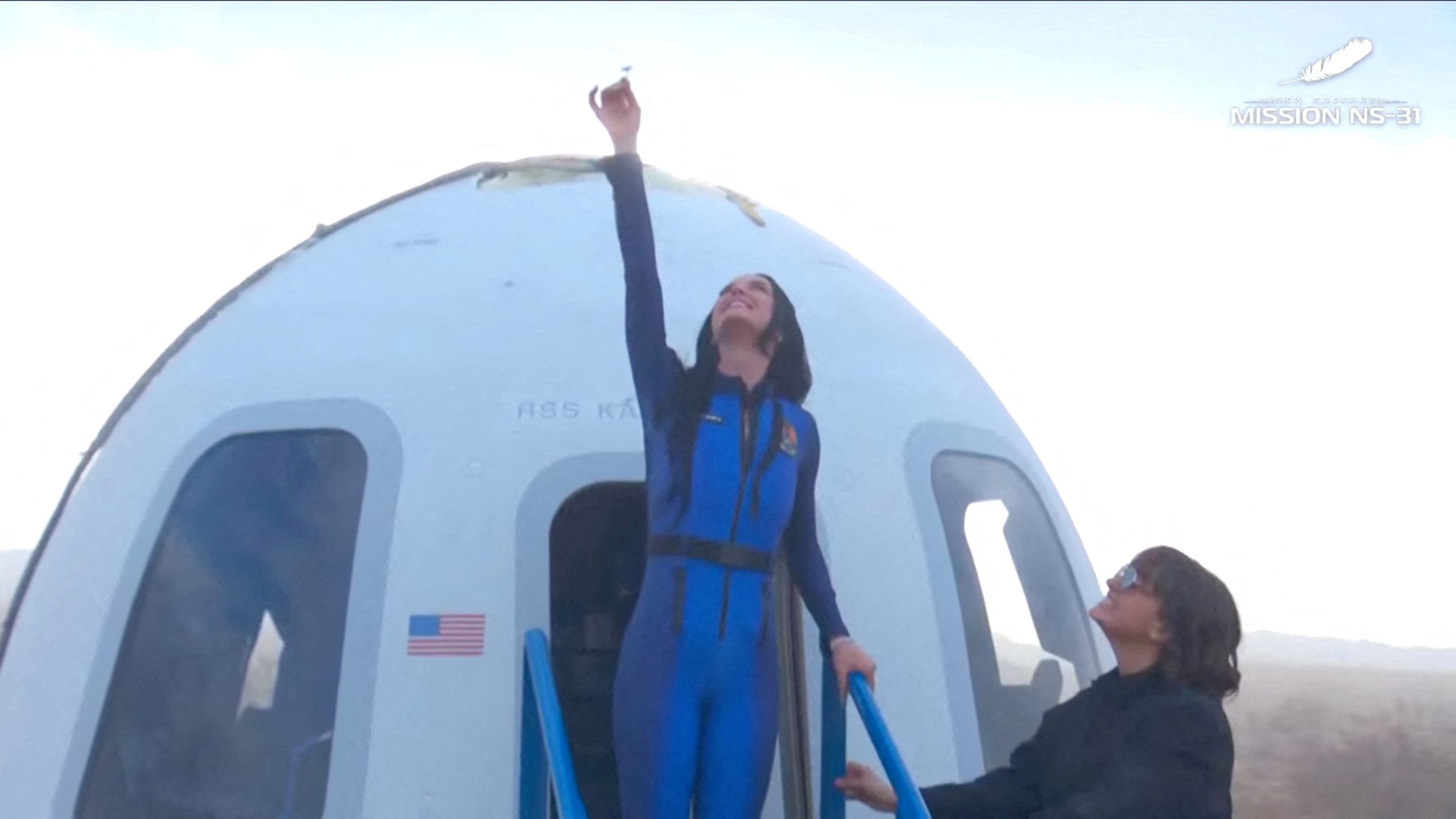When the most publicized all-female space crew in decades is asked more about mascara than mission objectives, it’s clear we have a problem.
On Monday at 9:30 AM EDT in Van Horn, Texas, six women boarded Blue Origin’s NS-31 for a flight into space—one that the company and media outlets are branding as a historic feat. The all-female crew included aerospace engineer and entrepreneur Aisha Bowe, documentarian Kerianne Flynn, broadcast journalist Gayle King, Nobel-nominated activist Amanda Nguyen, pop star Katy Perry, and Lauren Sánchez, media personality and fiancée of Jeff Bezos, who owns Blue Origin.
The launch is being framed as a momentous occasion in gender representation, but when “representation” is neatly packaged and handed to us, it demands a closer look. Who is it really for, and what is it actually saying? Is it enough to simply see women in a space capsule, or do we need to ask deeper questions about the substance of their inclusion?
On paper, this crew filled an important role in space history: it’s the first all-female spaceflight since Valentina Tereshkova’s solo Soviet mission in 1963. But scratch the surface, and it’s hard not to feel like this is less “one giant leap for womankind” and more a glittery PR stunt wrapped in the language of empowerment.
“It’s been more than 60 years since a woman travelled into space without a man. And now six of them are blasting off from Earth,” Sky News reported.
Let’s be clear: some of these women are undoubtedly qualified. Aisha Bowe has a degree in aerospace engineering and leads a successful government tech company. Amanda Nguyen has changed the legal landscape for sexual violence survivors and just became the first Vietnamese and Southeast Asian woman to go to space. Their presence is meaningful. But why are their achievements being lumped together with Katy Perry’s Grammy nominations and Lauren Sánchez’s bestselling children’s book?
And why did Elle, instead of asking about the crew’s views on space policy, STEM education, or the historical significance of the mission, ask them about what they’re packing in their carry-ons? Why does Katy Perry need to clarify that she’s not bringing false lashes and that they will get professional makeup done pre-flight? Why are we hearing more about “low-maintenance glam” than the actual mission parameters or scientific objectives?
Katy Perry looks fantastic for space journey. pic.twitter.com/POtz9u5eBI
— Pop Crave (@PopCrave) April 14, 2025
“This will be the first time anybody went to space with their hair and makeup done,” Elle quipped to Katy Perry, moments after they wrapped the “making history” segment of the interview.
It’s this treatment that infantilizes and trivializes women’s place in space exploration. The tone of coverage, most of which centers on outfits, motherhood, and looking cute while floating, feels straight out of a 1950s lifestyle magazine, not a 21st-century scientific milestone.
“We are going to put the ‘ass’ in astronaut,” Katy Perry told Elle prior to launch.
This isn’t progress. It is packaging strategically suited to make Bezos’ expensive Blue Origin advertisement shine just right, pushing a performative feminist agenda when the women aren’t even the ones behind the wheel. When representation is reduced to optics, it becomes a hollow symbol and a surface-level win that glosses over the real structural inequalities still in place.
Space tourism isn’t progress. It’s privilege with a jetpack.
A few billionaires launch themselves into the stratosphere while emissions spike and Earth warms.
This is climate vandalism, dressed as innovation.#SpaceColonialism #ClimateCrisis #BlueOrigin— angela dion (@dionontheearth) April 14, 2025
We don’t need celebrities in space to inspire girls to pursue STEM. We have trailblazing astronauts like Suni Williams, who logged over 600 days in space and became the first person to run a marathon in orbit. She didn’t get there by being glamorized on magazine covers. She got there through grit, skill, and a three-and-a-half-decade career in the Navy and at NASA. Peggy Whitson became the first female commander of the ISS 18 years ago. And eight years prior, Eileen Collins became the first female shuttle commander.
The truth is, there’s a powerful lineage of pioneering women who’ve carved their place among the stars—and the stories of women like Williams, Winston, and Collins inspire and lead in tandem.
We should be spotlighting women like Bowe and Nguyen because of their extraordinary qualifications, not sidelining their expertise in favor of spectacle or fame. A true milestone would be sending underrepresented scientists, engineers, and astronauts to space on meaningful missions with real goals, not designing zero-gravity photo ops for rich, famous people who, at the bare minimum, fit the mold.
And moreover, women don’t need to be astronauts to be bold, brilliant storytellers or adventurers. That’s been proven time and time again by cultural powerhouses like Katy Perry, who is a 12-time Grammy nominee, a respected Unicef Goodwill ambassador, and was Billboard’s 2012 Woman of the Year. She’s undeniably a national treasure. But that doesn’t make her qualified for spaceflight, and it doesn’t necessarily send the most accurate or inspiring message to girls who dream of exploring the cosmos.
So no, this doesn’t need to be the future of women in space. It’s an incredible joyride, no doubt, and will likely be remembered as a life-changing experience for each of the six women who got to look back at Earth and, quite literally, see the big picture. But the problem isn’t the women—it’s the structure that reduces them to live-action dolls in a carefully curated ad campaign. Representation without substance is not the progress we were promised. If we’re going to get serious about gender equity in STEM, we need more Suni Williams and fewer lash-curler Q&As.






